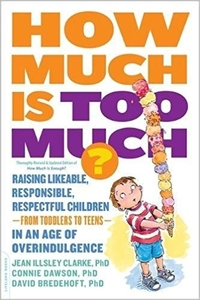Overindulgence is not a new concept. Everyone knows the spoiled brat became that way because she never heard the word “no” from her parents. What is new is that the spoiled brat is becoming the new normal. Current American society has lowered its expectations of children so much that a polite child is a remarkable one. With so much information available to parents, so many resources and gadgets to make parenting easier, it is confusing for a parent to be a parent, especially if they were overindulged as a child. The research of Drs Clarke, Dawson and Bredehoft over the last twenty years have uncovered some startling truths about these overindulged children as they have become adults.
[alert variation=”alert-info”]Da Capo Lifelong Books:
Paperback, Kindle:
Purchase: Powell’s | Amazon | IndieBound | Barnes & Noble | iBooks[/alert]
In their book How Much is Too Much? overindulgence is described as more than just too many toys; it also includes too much attention and too much freedom. These researchers have found that adults who were given too many things as children were found to be careless of their items as adults, those who were over-nurtured experienced a lack of basic life skills as adults, and those that experienced soft structure (too much freedom) were found to have a cavalier attitude about laws and life goals. Ten separate survey studies were compiled consisting of over 3,000 adult participants. The book is separated into information about the different types of overindulgence, the characteristics the type of indulgence produces in adults, and some tools to recognize and avoid it.
“As parents we must learn to tolerate children’s discomfort at times so they can gain the important lessons about how to trust themselves.”
The message is so obvious in its simplicity and repercussions, but the solution is not easily come by. Society keeps making things faster and bigger and more, that in order for children to keep up with their peers, it seems a cruelty to deny them, especially if the parents can actually afford it. The suggestions put forth in How Much is Too Much? are affirmations parents can internalize as they go through their day-to-day operations. Perhaps being aware of the problem may be enough for some parents, but without concrete exercises, the knowledge presented in this book may be too easy to disregard as not applicable. If the parents can’t keep themselves from overindulging, how can they prevent their kids from doing the same?
This research is important. A change needs to happen because everyone falls prey to this habit of overindulgence in their adult lives and in parenting. How that change will come about is anyone’s guess, but this book offers a beginning.
[signoff predefined=”Social Media Reminder” icon=”twitter”][/signoff]

